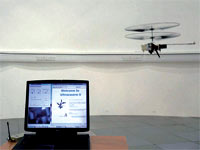Columns
Bits & Bytes
FUTURE TECH
 Researchers at the University of Essex are working on tiny helicopters that
swarm like real bugs for military surveillance. The goal of the Ultraswarm project
is to program the robots to move as one entity and carry out sophisticated tasks
using distributed computing techniques, according to project director Owen Holland.
The
flying robots weigh only 1.8 ounces, pack enough power to run the Linux 2.6
kernel and communicate via a
built-in Bluetooth module. Despite a key limitation—the helicopters are
too light to fly outdoors—Holland predicts the little sky spies will be
ready in weeks rather than months. Until then, the researchers will be busy
as bees working on the project.
Researchers at the University of Essex are working on tiny helicopters that
swarm like real bugs for military surveillance. The goal of the Ultraswarm project
is to program the robots to move as one entity and carry out sophisticated tasks
using distributed computing techniques, according to project director Owen Holland.
The
flying robots weigh only 1.8 ounces, pack enough power to run the Linux 2.6
kernel and communicate via a
built-in Bluetooth module. Despite a key limitation—the helicopters are
too light to fly outdoors—Holland predicts the little sky spies will be
ready in weeks rather than months. Until then, the researchers will be busy
as bees working on the project. |
PHOTO COURTESY OF UNIVERSITY OF ESSEX
WEB WATCH
There are fantasy baseball and football leagues, so why not one for tech stuff?
Yahoo! Research Labs and O’Reilly Media launched Tech Buzz, a fantasy
trading market for high-tech products, concepts and trends. Players start out
with $10,000 in funny money to play the Tech Buzz stock market; they invest
in technologies they think will succeed; and dump those they think will flop.
Stock worth, or buzz, is measured by Yahoo! Search frequency.
Prizes, including an Apple Mac Mini computer and iPods, are awarded to the
savviest techtrader. You can give it a try at: buzz.research.yahoo.com/bk.
10 YEARS AGO
In the July 1995 issue of ADT, Dr. Ramon Barquin and
Alan Paller warn of 10 common data warehousing mistakes. While data warehousing
was “starting to take the information industry by storm,” the unfettered
growth could compound mistakes, causing simple systems to “become unmanageable
at best and cease to function at worst.” Some mistakes include engaging
in politically naïve behavior, setting expectations that cannot be met,
and believing all problems are solved once the data warehouse is up and running.
They also warn that “believing there are only 10 mistakes to avoid is
in itself a mistake.”
A study from the Center for Project Management reports that only 5 percent
of software development projects are developed on time and within budget. In
addition, “another indicates that 1 percent of commercial software projects
are completed on time, within budget and according to specifications. Moreover,
75 percent of the projects begun are either never completed or arrive too late
to be useful.”
In “Demystifying the Black Art of Project Estimating,” Stan Zawrotny
looks at why “schedules look like they were developed by throwing darts
on a wall.”
HELP WANTED
According to Robert Half Technology, the job market for IT pros will improve
in the coming months; a net 11 percent of CIOs plan to add full-time IT staff
in the third quarter. This is the largest net increase in hiring in 3 years.
Fourteen percent of CIOs expect to add full-time IT staff, 81 percent will
maintain current staff levels, and 3 percent plan layoffs. If you’re looking
for work, the largest firms (1,000 employees or more) expect to do the most
hiring, and New England CIOs are the most optimistic about their hiring plans.
Now if you get a job, don’t expect to be rolling in dough. Compensation
for IT staffers hasn’t changed much in the last six months, according
to a study by Janco Associates. The average total compensation for IT workers
crept up 0.2 percent to $77,249 since January. At the same time, compensation
of IT executives rose by 1.6 percent to an average of $140,760.
NEW TECH
 Enterprises that need a product prototype—even one that doesn’t
actually work—typically must wait weeks before they get the thing in their
hands. New, rapid
prototype or 3-D printers, are now able to turn a CAD drawing into a 3-D object
within a few hours, sometimes for as low as $100 apiece.
Enterprises that need a product prototype—even one that doesn’t
actually work—typically must wait weeks before they get the thing in their
hands. New, rapid
prototype or 3-D printers, are now able to turn a CAD drawing into a 3-D object
within a few hours, sometimes for as low as $100 apiece.
Sony, Fisher-Price, Adidas, Canon, Kodak, Harley-Davidson, Lockheed Martin,
BMW
and Porsche are among several companies that have recently begun using 3-D printers
to build product prototypes.
The way 3-D, or rapid prototype, printers operate is similar to that of ink-jet
printers, putting down layer after layer of powder, with a bonding agent to
hold it together.
Five 3-D printer makers offer these machines, which start at $25,000: 3D Systems,
Z Corp., Stratasys, RP Systems and Object Geometries. Z Corp.’s Z810,
which sells for $180,000, is the only one on the market at the moment capable
of building multi-colored models. |
SECURITY
According to our sister publication Federal ComputerWeek, the U.S.
Army plans on creating six area processing centers to improve network security
management, starting with servers at four installations.
The first site will change to an area processing center in nine months, while
the other three will be migrated
in 12 to 18 months. These servers will host e-mail, Web services and most of
the storage. The Army plans
to use centers operated by the Defense Information Systems Agency, existing
service centers, or create
new ones.
The news comes on the heels of the Army’s initiative to have its IT workers
start operating as an enterprise organization, rather than independently. Army
officials want IT personnel to focus on delivering IT capabilities to soldiers
and meeting enterprise goals of better network operation, management and security.
LEFT/RIGHT BRAIN
IBM and The Ecole Polytechnique Fédérale de Lausanne have embarked
on a plan to map the neocortex, the
largest and most complex part of the human brain. Scientists from both organizations
will collaborate on what
they’re calling the Blue Brain Project, using IBM’s eServer Blue
Gene supercomputer. Using a digital model of the brain, the scientists will
run simulations at the molecular level, in expectation of shedding light on
internal
processes such as thought, perception and memory. Scientists also hope to understand
more about how and why certain microcircuits in the brain malfunction, as these
are thought to be the cause of psychiatric
disorders such as autism, schizophrenia and depression.
Blue Gene will be installed at EPFL and will occupy the floor space of about
four refrigerators. It will have a
peak processing speed of at least 22.8 teraflops, making it one of the most
powerful supercomputers in the
world, according to IBM.
The first phase of the project will be to make a software replica of a column
of the neocortex. The neocortex constitutes about 85 percent of the human brain’s
total mass and is thought to be responsible for the cognitive functions of language,
learning, memory and complex thought. An accurate replica of the neocortical
column is the essential first step to simulating the whole brain and will also
provide the link between genetic, molecular and cognitive levels of brain function,
the scientists say.

- Three Golden Columns: The neocortex is organized into thousands of columns
of neurons. Each column has a diameter of 0.5mm and contains 10,000 neurons.
The neocortex is also organized into six layers, and the golden neurons shown
are the large output pyramidal neurons in the fifth layer. In the background
are other neurons making up the neocortical column.
|
JOB MARKET
The Associated Press reported recently that India is beginning to see a shortage
of skilled labor in its back-office outsourcing industry and could fall short
by a quarter-million workers in 4 years.
“The problem is not with the quantity, but with the quality,” Rajeeva
Ratna Shah, an official of the federal Planning Commission, which directs India’s
economic strategy, said at an outsourcing conference in the southern city of
Bangalore, the center of India’s high-tech industry.
Only a fraction of the 3 million graduates produced by India each year are
ready to be employed in the outsourcing industry, with others needing several
months of training, Shah said. Most people who apply for back-office jobs lack
communication skills, knowledge of international practices and advanced computing
skills, said Kiran Karnik, president of the National Association of Software
& Services Companies, India’s technology trade body.
“Companies are able to select only eight or nine people out of 100 who
apply, and that’s a pretty low selection ratio,”
Karnik said. Nasscom has begun a plan to work with Indian universities to improve
skills needed for the outsourcing industry, he said.
Karnik also said the outsourcing trade body is taking steps to profile workers
in a central database to prevent
criminals from getting jobs and threatening the data security of global companies.